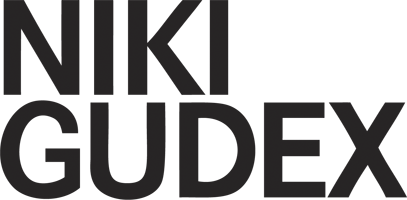Biker Chic
"Never happier than when off the beaten track, graphic designer, model, artist and champion mountain biker Niki ‘Dingo’ Gudex gives an insight into what it’s like."
"I like to go fast; it’s what drives me to race. It’s also how I accomplish as many things as possible at the highest standard possible. Because the harder you work for something the more personally rewarding it is when you succeed. Which is how, after only two years of professional riding, I won the Australian National Championships Series in both Downhill (DH) and Cross Country (XC) and represented Australia at the 2003 World Championships in Vail, USA, at 22. Funnily, at school I wasn’t sporty or athletic until I discovered snowboarding. I pursued it for nine years until I broke my back practicing flips on a trampoline. In the year it took to recover I realised ‘I’m not invincible’ and ultimately there’s a price for everything, especially if I go beyond my limits. It was a turning point. I moved to Jindabyne, but remained tentative on the snowboard. One day, I borrowed a friend’s bike, got lost, and broke a pedal on the ride back through the bush. At the bike shop the guy asked me if I raced.
Intrigued, I bought a bike and raced that Saturday. I entered the National Championships a week later and won my category – I haven’t looked back. At 21 I was quite old for a beginner but thanks to snowboarding I already had natural balance. Plus, I could identify the lines, rhythm and natural flow in the terrain, which is essential to negotiate steep hills, rocky terrain and obstructed paths at speed. However, being small, I needed to improve my strength and fitness. I did this by cycling 15-25 hours a week and mixing Pilates and boxing with weights at the gym and yoga. Yoga, massage and stretching really help to open up all areas, such as your arms, calves, thighs, and butt – even your stomach – that tighten from the repetitive cycling movements. Diet is also important. When training, I try to only eat whole natural foods including chia seeds soaked in water, added to yoghurt, cereal and toast for breakfast plus fruit. Lunch might be pasta with meat or a salmon, cheese and salad sandwich. My favourite dinner is steamed greens with salmon and an umeboshi plum or good quality meat. I also eat a lot of avocados and nuts; try to keep away from sugar, apart from dark chocolate; drink plenty of water; get lots of sleep and try to minimize stress. I must be doing something right as people assume I am in my early 20s and even though I’m 31 I don’t physically feel any different than I did at 26, except that I am more confident.
When you are out riding, you really get a chance to examine yourself and see who you are and where your strengths are. My best training rides happen when it’s hailing or something like that and I push through – I love stuff like that. The most important thing though is to keep it fun on and off the bike."
On your bike
If the last time you rode a bike it had streamers on the handles and playing cards in the spokes it may be time to saddle up. Here, Niki shares her tips to getting started.
How do I find a bike? Most people can get access to a bike, whether they borrow a neighbour’s or buy their own. It doesn’t matter what level you’re at, I think it’s something that everyone can enjoy.
How do I know what bike is right for me? Buy the best frame and fork that you can afford, and worry about the components later. When you look at your bike in two years, you will probably have replaced a lot of the components through wear and tear. So think about the riding that you want to do and buy a bike to suit that.
How do I race if I’m out of shape? Just pick up a bike and go. Racing is more than the pros; there are categories for every rider’s ability.
How do I find a group? Visit your local bike shop and find out about local trails. Alternatively, contact your state’s cycling organisation for clubs near you.
What are the essentials? As well as a bike, you need a well ventilated helmet, sunscreen and clothing: bright, light jerseys and bike shorts (knicks have a built in chamois for extra padding) to prevent chafing, and a hydration pack. Eye protection is also very important: rocks, sticks and debris can easily fly up and hit you in the eye, something which can be avoided by being prepared. If you are doing downhill, body armour is a good idea, including gloves, as your hands tend to be the first things that hit the ground when you crash.
What are the heath benefits of mountain biking? You lose weight and it’s a great cardiovascular workout that’s great for your legs. You’ve got to lift your bike over bumps and push it around, which gives you an all over workout, and the tougher the terrain, the more calories you’ll burn.
Profile: Leo Wiles. Photographer: Ian Hylands. "Biker Chic" Goodlife Magazine, Autumn 8 Issue 2010


